by John M. Hotchner
 Is there one unalterable truth for stamp collectors? If so, I would propose that it is a universal feeling that U.S. stamp design is less than spectacular, and many of us share a belief that if we were running things, we could do better. Perhaps.
Is there one unalterable truth for stamp collectors? If so, I would propose that it is a universal feeling that U.S. stamp design is less than spectacular, and many of us share a belief that if we were running things, we could do better. Perhaps.
In the past two days, I have heard complaints about the Forget-me-not stamp (It needs a frame to focus the design), the last George Washington stamp (It is too dark and George is lost in the dark framing), the Winter Flowers issue of 2014 (They look too much like Easter seals), and the World Stamp Show publicity stamps (A lost opportunity to picture stamp collecting or classic American stamps.)
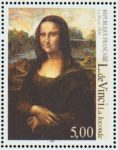 While any or all of these criticisms may have merit, it is all second-guessing. And my guess is that all artists — even the great ones — had to put up with similar carping (“That’s supposed to be a smile on Mona Lisa? Looks more like she’s
While any or all of these criticisms may have merit, it is all second-guessing. And my guess is that all artists — even the great ones — had to put up with similar carping (“That’s supposed to be a smile on Mona Lisa? Looks more like she’s
suffering a gas attack after too many baked beans!”)
Well, we as collectors have the right to criticize, but it is all hot air unless we actually do something about it. And there are several strategies.
- Don’t buy what you don’t like. Avoid such issues for use as postage, for your albums, and for gifts for children and grandchildren. The USPS tracks closely what sells, and just as important, what doesn’t. Vote with your wallet.
- Learn how to draw a neat “X” in the album page box for stamps you will not add to your collection because you don’t like the art style, or you class them as just plain ugly. You are the arbiter of what makes the cut. And no one has to agree with you.
- Create a Hall of Shame — a special section of your album in which you place all the stamps that annoy you.
- If you have more stamps in that section than on your printed album pages, maybe it is time to curtail your collecting by ending at a given year.
You will need to be careful to differentiate whether it is the design you dislike or the subject. Sometimes, our view can be so colored by dislike of the subject that no design will hit the mark. On the other side of that fence, the flood of multi-colored fruits, flowers, foliage, fauna, flyers, food, and flags may have great popularity with the American public, but only a few stand out as clever and original depictions.
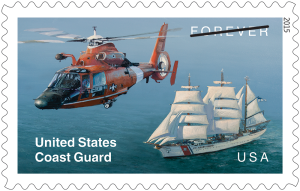 In my view about 10% of U.S. issues really rank high on both subject and design scales.
In my view about 10% of U.S. issues really rank high on both subject and design scales.
One in the 2015 crop is the U.S. Coast Guard commemorative released August 4. Full disclosure: I was involved in development of the subject while a member of the Citizens’ Stamp Advisory Committee (1998-2010) but it had not gone to the artists at the point that I timed out from the Committee. So I was surprised and delighted by the exceptional art that illustrates the 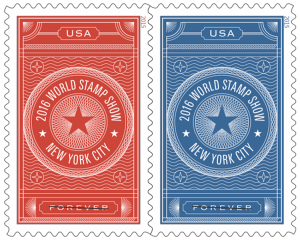 subject.
subject.
Contrast that with the New York 2016 publicity pair (right) — a good subject that in my opinion is a generic and uninspiring design that will inspire no one to attend the show.
What can we reasonably expect from U.S. stamp design? Certainly, we need to recognize that in stamps as in art generally, there will be a range of style. This is right and proper as stamps are a reflection of the breadth and diversity of American art; much like the stamp program having a commission to reflect the breadth and diversity of America itself and its population.
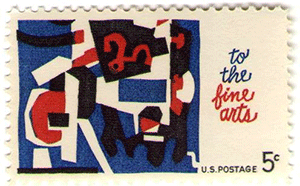 I well remember when modern art first made its appearance on a U.S. stamp with the 5¢ “Fine Arts” issue of 1964 (left). One would have thought listening to the reaction of collectors that the world as we knew it had come to an end.
I well remember when modern art first made its appearance on a U.S. stamp with the 5¢ “Fine Arts” issue of 1964 (left). One would have thought listening to the reaction of collectors that the world as we knew it had come to an end.
There were similar protests when children’s art in the form of stick figures on the 20¢ Family Unity issue was included in 1984. And when cartoon-type art made its first appearance with the 1991 “Comedians” set of 29¢ stamps using the pen-and-ink impressions of Al Hirschfeld.
 They were later followed by actual cartoons from the comics section of our daily press.
They were later followed by actual cartoons from the comics section of our daily press.
The latter complaints were especially mystifying to me as both political cartoons and the so-called “funny papers” are features of American journalism that have been developed to a high level in the United States. Stamps celebrating these American institutions are right on the mark, and the art is appropriate.
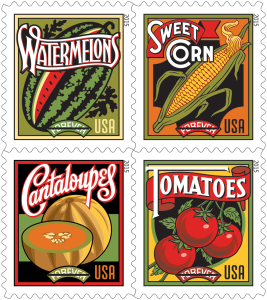 I personally don’t enjoy much of the poster art that has been and is used. The “Summer Harvest” issue is an example (right). And as to modern art, I think much of it is a fraud on the public when presented as works of inspiration possessed of deep and profound meaning. And yet, a portion of the public buys it and goes to see it in museums.
I personally don’t enjoy much of the poster art that has been and is used. The “Summer Harvest” issue is an example (right). And as to modern art, I think much of it is a fraud on the public when presented as works of inspiration possessed of deep and profound meaning. And yet, a portion of the public buys it and goes to see it in museums.
Can the U.S. stamp program ignore that? Should it? Regretfully, I have to admit that
it has its place.
So, my conclusion is that it is irrational to expect that every issue will please every collector. In fact, the USPS can expect criticism of some sort on the majority of its issuances if for no other reason than that the American public has a wide variety of likes and dislikes, and a wide variance of art appreciation, from those of us who merely know what we like, to those of us educated to know what we should like.
Which means that criticism will be plentiful and conflicting. And the USPS needs to listen to it, but act on it sparingly.
Should you wish to comment on this column, or have questions or ideas you would like to have explored in a future column, please write to John Hotchner, VSC Contributor, P.O. Box 1125, Falls Church, VA 22041-0125, or email, putting “VSC” in the subject line.
Or comment right here.




John, I think your observations on this topic are spot on. One additional criticism I would offer is for USPS to reduce or eliminate black stamps. Over the last two decades USPS has issued literally dozens of stamps with black backgrounds that go clear to the edge, with no white margins. I make lots of event covers, and too often the black stamp that pertains to the occasion conceals important parts of the postmark. And even from a non-philatelic viewpoint, these stamps are candidates for re-use because the cancellation is difficult to see. That is inimical to “protecting the revenue”.
I agree that the US is filled with too many varieties of people to even think about making everyone happy subject-wise. I am disappointed frequently by the execution of the subject. For example, the upcoming Sarah Vaughan stamp – when I saw it, I thought “What an unfortunate looking woman!” But then I looked her up online and she is not unfortunate looking at all! And the Star Trek stamps – so disappointing! If you can’t do better than that, don’t do it at all.
On the other hand, sometimes the USPS hits it out of the park. The planet stamps are a joy to use. And a few years back, I couldn’t get enough of the Negro League Baseball stamps or the William H. Johnson art stamps!